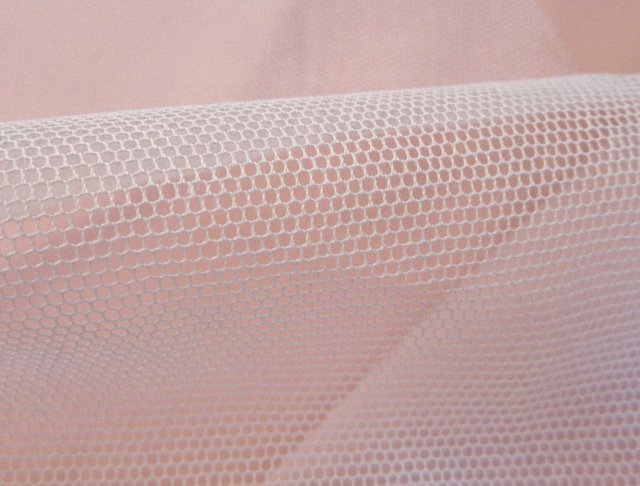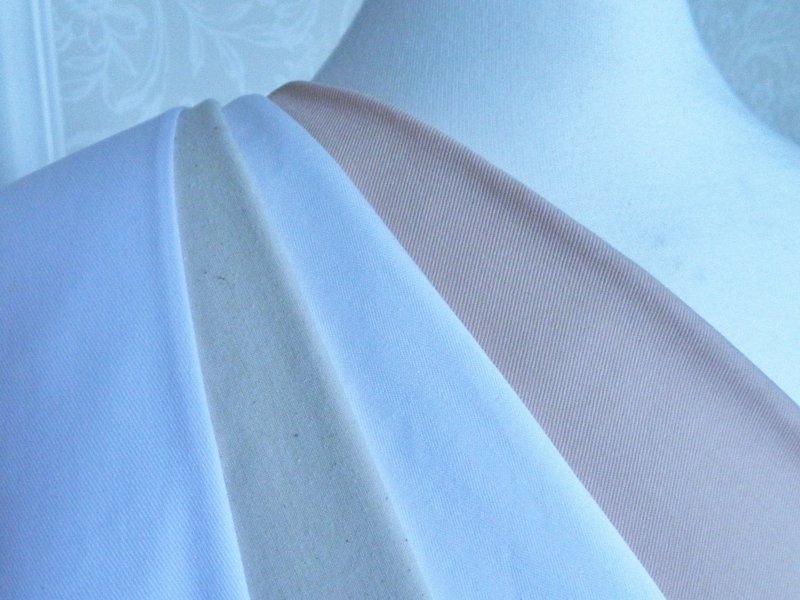Linings used for Tutus
ALWAYS pre-wash and Iron your Lining fabrics, especially cottons, as they do shrink. Stretch Linings i.e. Power net can be washed on a
cool setting or rinsed by hand. These do not need pressing.
Tutus
COTTON COUTIL –
I use 100% Cotton Coutil on my Professionally made Tutus. This is the most durable and kindest to the skin. The cotton absorbs perspiration and helps protect the outer, more delicate top layer of the Tutu fabric.
The dense herringbone weave prevents the boning from coming through the fabric and so is more comfortable to the dancer.
A standard 10 piece Adult bodice needs about half a metre.
COTTON DRILL –
A strong Cotton Drill is also suitable for Tutus which don’t need to last 20 years and is under less stress. Younger students Tutus can be made successfully with the lighter linings as these are not constrained to the same rigours as the Professional Dancer.
The Coutil and drill can be dyed a flesh colour when the top fabric is thinner or more see through as this is less visible through the fabric.
COTTON TWILL –
A softer cotton Twill is also suitable for younger dancers.
POLY COTTON TWILL –
A Poly cotton Twill which is 65%Cotton and 35% Polyester can be used for Tutu linings. The young girls using their Tutus for a short few minutes at a time can use the Poly cotton Twill without any problems. It is lighter in weight than the Drill and Coutil and still absorbent with the high percentage of cotton in it. It is not necessary to use strong heavy Coutil in Young girls Festival Tutus. If the top fabric being used is very fine then it is an option but I think each costume has its own needs and particulars.
COTTON POPLIN –
When a heavy top layer of fabric is used for a Tutu then a light cotton Poplin or such can be used for the Lining. Some manufacturers use a fine cotton. This doesn’t last long and deteriorates more rapidly but can be used if necessary .
If the fabric weave is loose then there is more likelihood of your Tutu not withstanding much use. Do research and find out about sewing and using different woven fabrics.
Stretch Tutus
Most stretch Tutus are one to two layers of Lycra and so do not need a lining. If one is needed then a stretch lining must be used i.e. power net or swimwear lining. The Power net lining helps strengthen the Tutu and provides support for the top fabric.
Tutu Panty
There are numerous preferences for the panty and it is also dependent on various factors such as the Dance, Age of student, Country and Designer and budget.
POWERNET –
Power net medium or firm weight can be used single layer or doubled up. The advantages of this in a Company where a Tutu needs to fit a couple of dancers, is it adjusts to fit (within certain limits). It can also be dyed to match the Lower ruffles so to make it less noticeable and it helps lengthen the line of the dancer.
COTTON BOBBINETTE –
I prefer using Cotton Bobbinette for Professional Tutus as it is breathable and kinder to the body. Its unique construction makes it extremely strong. The Cotton Bobbinette accepts dye readily and holds the Ruffles well.
I use it doubled up but it can also have a layer of tulle in-between.
It is an expensive option and does shrink (on the width especially) so needs to be HAND washed around a temperature of 30 degrees and air dried before using.
COTTON LAWN AND POLY COTTON –
A good Cotton Lawn fabric doubled up is also suitable and a Poly cotton is sometimes used for younger students.
However each situation is different and calls for different solutions so there is never a hard and fast rule. There are so many different opinions on fabrics and Linings you can use to construct Tutus, mine is just one of them.
 Valorose Tutus and Textiles
Valorose Tutus and Textiles

